NATURALIST’S NOTEBOOK APRIL 25 TO MAY 1st 2009
On April 25th the skies were clear and the wind was moderate. We didn’t travel far before we had our first marine mammal sighting, a harbor seal that was resting on Long Point. Unlike whales, seals are semi-aquatic, meaning that they spend time on land and in the sea. Seals are frequently sighted resting on beaches where they give birth to their young, nurse their young, and molt. Harbor seals are sometimes referred to as the “common seal” as they are the most wide-ranging of the pinnipeds and are considered to be a true seal. Harbor seals are commonly found in the Northern hemisphere, among a multitude of other locations. Their diet is diverse, as they have been observed feeding on various species of fish including menhaden, anchovy, sea bass, herring, cod, whiting and flatfish. Harbor seals also feed on shrimp, mollusks and squid, although they feed less often on such creatures. Shortly after we left our harbor seal we came across several humpback whales, one of which was a whale named Aerospace. Aerospace was engaging in an active behavior called flipper slapping, whereby the whales long, white pectoral flippers (a third the length of the whale’s body) was lifted out of the water and was slapped on the water’s surface. Although it is unclear why humpback whales engage in such behavior, some researchers believe that it may be a form of communication or play. We also observed Roswell’s 2007 calf and several juvenile humpback whales, fin back and minke whales.
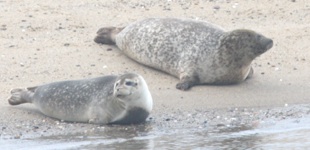
Harbor seals, hauled out
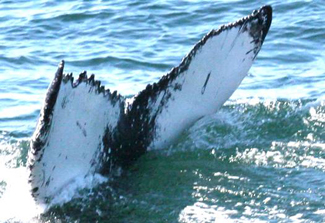
Aerospace
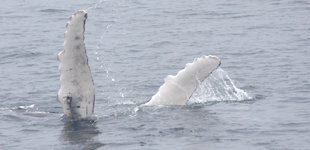
Flipper-slapping
On April 26 the Dolphin VIII sailed out to Cape Cod Bay with ideal whale sighting conditions. A myriad of marine life was observed, with several grey seals, humpback, minke and fin whales sighted from the vessel. Our first humpback whale was an adult female named Trident. Trident frequently visits Stellwagen Bank and was entangled in fishing gear a few years ago. Luckily, PCCS’s disentanglement team was able to free her from the fishing gear. Happily, Trident was seen shortly after her release with a new calf. Our third humpback was engaging in a resting behavior, commonly referred to as logging. Humpback whales are conscious breathers meaning that they have to decide to come to the surface to breath. The active process involved in breathing prevents the whales from actually achieving a full sleep, so the whales achieve a state of rest by switching off half of their brain, while using the active half of the brain to remind them to come to the surface to breath. Towards the end of our trip we found Nazka and Tongs, who were participating in surface feeding activities.
April 28th was an exciting day to be out on the whale watch boat. We had the privilege of seeing a v-shaped spout, characteristic of the critically endangered North Atlantic right whale. In an effort to protect the small population, vessels are not allowed to approach a right whale within 500 yards, so we admired the whales from afar. Right whales are among the most endangered large whales on earth, with approximately 350-400 individuals remaining in the North Atlantic. Centuries of commercial whaling almost decimated this once abundant population. Right whales were actually given the name the right whales because they were considered the right whale to hunt. Whalers profited almost effortlessly by harpooning the slow moving whales and then harvesting their blubber. Although whaling has been banned for almost 60 years, the whales do not appear to be demonstrating significant signs of recovery. Human caused mortality due to vessel strike and entanglement in fishing gear threaten the survival of the species. In an effort to try to prevent human caused mortality, researchers study the distribution of right whale food in Cape Cod Bay from January until mid-May to try and predict whether the whales will be in areas of high risk (vessel strike and entanglement). The Department of Marine Fisheries and the Environmental Police mitigate vessel strike and entanglement by enforcing fishing gear, vessel speed and distance restrictions in Cape Cod Bay. This year we had hundreds of right whales visit the bay and a record number of calves born. Hopefully with increased awareness, research and conservation, the whales will begin to rebound. Additional whale sightings included, 5 humpback whales, 2 fin whales and 1 minke whale!
We set out of Provincetown harbor on April 29th with ideal whale sighting conditions, calm seas and bright skies. Within a few miles off town we found ourselves surrounded by various forms of marine life, including 3 fin whales, 26 humpback whales and 50 Atlantic white-sided dolphin! A small group of four humpbacks were participating in a feeding behavior called kick-feeding, which is a feeding behavior specific to the Gulf of Maine. Kick-feeding usually consists of one or more lobtails at the surface and is followed by a dive and sometimes bubbles. The purpose of this behavior is essentially to stun or confuse the prey (sand lance) making it easier for the whales to trap the fish inside their plates of baleen. One of the feeding whales was Lavalier, who was accompanied by her 4 month-old calf. Lavaliere has arrived having fasted for the winter in the Caribbean and now needs to maximize her food intake so that she can build a large blubber layer to allow her to continue nursing her young and prepare her for another winter migration. We also saw Ravine, Barb, Putter, Thumper and calf, Apex, Nile and Pipette!
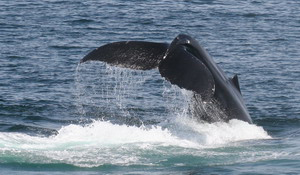
Kick-feeding
The dolphin VIII traveled into Cape Cod Bay on April 30th with beautiful sea and weather conditions, as the seas were almost flat calm. We saw vast numbers of fin whales and Atlantic white-sided dolphins. Fin whales are the second largest whales in the world; they can reach up to 79 feet in length! Fin whales are very sleek and fast swimming animals and can reach swimming speeds of 12.5 miles per hour. The speed and maneuverability of the species has limited their natural predators, making killer whales and humans the most significant fin whale predator. The whales have a remarkable asymmetrical color pattern with a white lower-right jaw and a dark lower-left jaw. Fin whales also have a light pale chevron on their back behind their head, which is sometimes used to identify individuals in the field. The trailing edge of the whale’s dorsal fin is also used for individual identification. Fin whales come to Cape Cod Bay and Stellwagon Bank to exploit the abundant supply of sand lance, although they also feed on krill, herring, capelin, squid, and plankton crustaceans. Unfortunately, fin whales are considered to be endangered, with eastern temperate North Atlantic population estimates to be around 7,500 individuals. Towards the end of our trip we spotted Salt, perhaps the most infamous humpback whale in the Gulf of Maine. Salt was traveling with her long-time female companion Cardhu and two other unidentified humpbacks (probably juveniles). We also saw Filament, Reflection and calf and Buzzard.
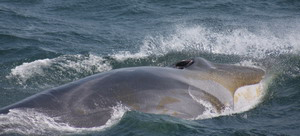
Right side of charging fin whale
Soon after leaving Provincetown on May 1st, we found multiple fin whales, harbor seals and humpbacks. One of the humpbacks was breaching, which is an active behavior whereby the whales leap from the water either in a vertical or horizontal motion. When whales breach they often show at least 40% of their body. For humpbacks to complete a successful breach they must travel horizontally at top speed (15 knots). It is most impressive to see a humpback calf breaching as it requires a tremendous amount of energy and strength to perform such a spectacular act. Although the reasoning behind such extraordinary behavior is still unknown, scientists speculate that it may be a form of communication between social groups or play. It has also been observed that breaching is often a repetitive and contagious behavior—once one whale begins others are often soon to follow. Whales are also more likely to breach when the wind increases and consequently the seas are rougher. We left our trip feeling very excited to have witnessed such a remarkable behavior and look forward to our next trip.
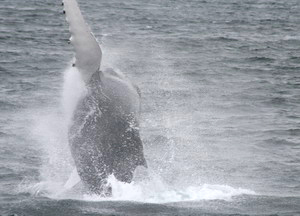
Trident, breaching





